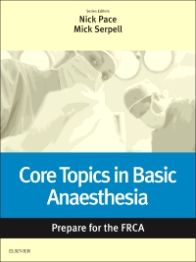Author Information
Edited by Nicholas Pace, FRCA FRCP PhD, Honorary Clinical Lecturer, School of Medicine, University of Glasgow and Consultant Anaesthetist, Gartnavel General Hospital, NHS Greater Glasgow & Clyde, Glasgow UK.
Section 1: Physiology
Principles of artificial ventilation
Applied respiratory physiology
The organization and composition of body fluids
Regulation of fluid and electrolyte balance
Action potential: generation and propagation
Nerve cell function and synaptic mechanisms
Section 2: Pharmacology
Intravenous anaesthetic agents
Inhalational anaesthetics
Neuromuscular blocking agents and reversal agents
Crystalloids, colloids, blood, blood products and blood substitutes
Section 3: Equipment & Physics
Medical gases, their storage and delivery
Physics of gases
Gas, tubes and flow
Mechanics (including force, mass, and acceleration)
Physical principles of LASER
Electricity and magnetism
The anaesthetic machine
Anaesthetic breathing systems
The principles of anaesthetic vaporizers
Humidification devices
Equipment for airway management
Suction devices
Section 4: Measurement
Basic measurement concepts
SI Units
Electrocardiogram and arrhythmias
Monitoring arterial blood pressure
Central venous pressure and pulmonary artery pressure monitoring
Measurement of gas volume and gas flow
Measurement of gas concentrations (O2, CO2, N2O and volatile agents)
Measurement of pulse oximetry, capnography and pH
Monitoring techniques, neuromuscular blockade and depth of anaesthesia
Measuring temperature
Processing storage and display of physiological measurements
Common errors in clinical measurement
Section 5: Preoperative Care
Consent
Premedication
Preoperative assessment in patients presenting for elective surgery
Assessment of the emergency surgical patient
Identification of the difficult airway
Prevention of deep vein thrombosis and pulmonary embolus
Section 6: Intraoperative Care
Induction of anaesthesia
Tracheal intubation
Positioning the surgical patient
Maintenance of anaesthesia
Fluid therapy for anaesthetists and intensivists
Regurgitation and aspiration
Anaesthesia in the obese patient
Section 7: Postoperative Care
Extubation and emergence
Patient recovery and the post-anaesthesia care unit (PACU)
Postoperative nausea and vomiting
Section 8: Adverse Events
Critical incidents: The respiratory system
Cardiovascular system: critical incidents
Dental damage in anaesthesia
Test Yourself: MCQs











